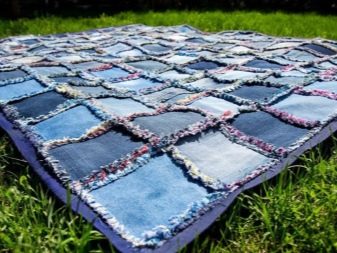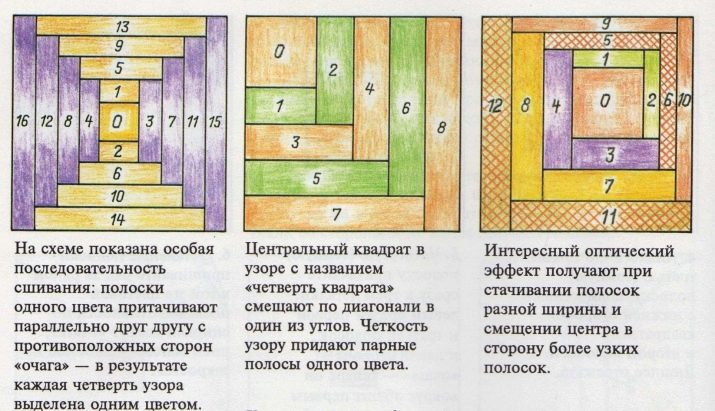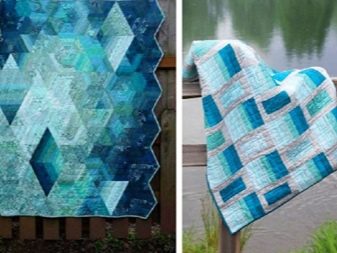An original blanket made of jeans shreds is the thing that will help to create spectacular accents in the interior and make the style of your home unique, modern, in the spirit of the latest trends. We offer ideas, descriptions, analysis of popular techniques.

Features and sewing rules
The history of patchwork sewing totals more than one hundred years. Our great-grandmothers perfectly mastered the art of harmoniously combining different pieces of fabric. This is a fairly creative and exciting activity.
Patchwork is done in the style of patchwork, and this is a great way to put into business the remaining trimmings, patches and pieces of fabric. This sewing technique is simple and allows even a novice needlewoman to create original attractive things.
Most often these are plaids, blankets, bedspreads, pillowcases for pillows, wall and floor mats. Products made in this style are always at the peak of fashion.


A patchwork quilt or bedspread is an indispensable thing in household goods, belongs to the category of home textiles, creates a unique warm atmosphere and coziness, is an exclusive expression of the creative beginning of a needlewoman, has its own unique style, harmoniously complements the interior of the room, adding some zest to it.
A plaid or a blanket of jeans flaps looks very relevant and fashionable. Such a thing, thanks to strong denim, will last for many years and never go out of style. Previously, patchwork technique was used for lack of fabric, for poverty, as they say. Now it is a fashion trend.And the craftswomen use in creating their works not only unnecessary scraps, scraps, old things. Today on sale you can find whole sets for patchwork with cuts of a completely new fabric. They are created by professional designers, updating collections annually.


Overview of flap stitching techniques
There are several flap stitching techniques - simple and complex. For beginners, it is better to use the simplest method - squares that are cut into a finished piece. This technique of stitching flaps is simple and even the most inexperienced beginner needlewomen can afford. The product can be made not only from squares, but also from circles, rectangles, triangles and other geometric shapes. Just squares are the easiest sewing option in the patchwork. Consider the most popular techniques for joining pieces of fabric.


"Well"
This option for stitching segments of matter is quite simple: the patches connected in a special way create the illusion of the depth of the well. Quite creative and original technique, has several centuries, the greatest popularity was in Europe and America. The technique is based on a square, which consists of individual strips of different fabrics. There are several options for connecting strips (they are also called "logs").

The most popular and easiest way:
- to the central square (it is the center of composition and color accent), colorful stripes are stitched in a spiral, light and dark;
- the first two strips are sewn to the opposite sides of the square, each subsequent strip is stitched in such a way as to capture the previous element.
The movement is clockwise. When the main tier of the well is ready, the technique is repeated, tiers are built up in a similar sequence. It turns out something like a fashionable 3D-picture, voluminous and deep.


"Watercolor"
The watercolor technique allows you to create a product with different shades and tints. Individual parts need to be connected in series to create a color composition. Each element is a tone lighter or darker than the main color, darker tones are first stitched, then lighter ones are added.
From jeans in this technique to make a coverlet is quite difficult, but possible. The color palette of denim is limited to several shades, so the selection of shreds and alignment of the color sequence will take longer.


"Fast squares"
The easiest and most affordable version of the patchwork for beginner needlewomen. This technique allows you to sew a bedspread in a few hours.. To do this, cut 3-4 rectangular strips of fabric of different colors, grind them along the long side. The result is a single piece of canvas, from which squares of blocks of the right size are cut, then the blocks are interconnected.


Crazy patchwork
This technique is for advanced and experienced needlewomen. Products made in this technique are real works of art. Crazy patchwork allows the connection of various fabrics of any geometric shape and color in random order, from swept pieces of fabric or curly trimmed around the edges. All seams are decorated with an embroidered flat or embossed seam, braid, lace ribbons, beautiful buttons, beads, beads, glass beads, chains.
The craftswoman must carefully sew together all the sides of the patchwork elements, even the smallest scraps of fabric can go into business. The idea of the technique is to randomly combine various pieces of fabric and decorate them later.
This technique allows the needlewoman to show her imagination and talent as a decorator.

By stripes
Sewing a beautiful, spectacular product in this technique is not at all difficult. The technique is based on sequential stitching of fabric strips of different colors of the same length and width in different combinations. The strips are neatly cut from a worn jeans and combined according to the selected pattern and color palette.This technique allows each needlewoman to show her fantasy and creative inclinations. To facilitate stitching, You need to develop a plan for connecting the pieces and their color in advance.


Which fabric is suitable?
The denim can be sewn from old jeans. Durable pieces of jeans will be required for this purpose.
Places where the fabric is worn or torn, is not recommended. A thing made using durable denim rags can last a long time.
When choosing a material for bedspreads, it is important:
- use only one-piece durable jeans flaps;
- take jeans cuts of the same shade;
- with a combination of multi-colored rags, it is better to choose the fabric of the same structure and thickness so that individual fragments of the canvas do not stand out and spoil the overall impression of the thing;
- pieces of fabric with holes, patch pockets, with rivets are not suitable for the manufacture of bedspreads.


Necessary tools
To create a product from worn jeans, you need to arm yourself with the materials and tools necessary for this work.
- Unnecessary jeans, preferably several pairs. First of all, you need to prepare the raw materials: carefully select suitable pieces of fabric for sewing, do not take places with yellowness or a changed color.
- Choose lining fabric. The lower part of the bedspread should be strong, soft, warm. For this purpose, it is advisable to choose a fabric made from natural fibers, it is best to use wool, satin, linen. In order to save, instead of wool, a synthetic winterizer or batting can be used. Then, as a lining material, you can take any thin cotton fabric of a suitable color or plain.
- Choose a fabric for processing borders all over the perimeter of the bedspread.
- Threads and sewing needles must be thick and durable.. Stitching denim is not easy because of its thickness. It is better to take the threads in color to the tone of the main fabric or in contrast to visually highlight the stitched details and elements.
- Thick cardboard for the manufacture of stencil patterns, a centimeter tape, a pencil, a thin piece of dried soap or chalk for marking parts on pieces of fabric.
- Tailor needles for chipping parts before grinding, sharp tailor's scissors, a special knife for opening seams or small scissors for manicure.
- Sewing machine. Special foot for sewing thick, coarse fabric.


How to sew with your own hands?
If you have little experience in sewing such products or it is not available at all, look at the master class of experienced craftswomen on the Internet. Visual videos or step-by-step photos give a complete picture of the upcoming work, which is divided into certain successive stages.
First step.
- It is necessary to decide on the basic materials, prepare all the necessary tools, decide what kind of bedspread will be: single-layer, two-layer, with or without decor. Prepare raw material from jeans and additional fabric for the lower part of the bedspread and its edging.
- Calculate squares accurately (other elements), determine their size depending on the desired width and length of the bedspread. At this stage, it is necessary on paper to conditionally divide the entire canvas of the future bedspread into equal squares and calculate their dimensions, also calculate the amount of turning, adding 5 cm from each edge. You will get 2 widths and 2 lengths with 5 cm added on each side (in total difficulty need to add 40 cm).
- Prepare stencils from thick paper or cardboard.


Second phase.
- Choose patterns, patterns of the future product, depending on the taste, desire and imagination of the craftswoman. Beginners most often take the “Quick Squares” scheme, more experienced needlewomen prefer the “Well”, “Watercolor” or “Crazy patchwork” technique.
- Cut the fabric into separate parts, mark out seam allowances on each and carefully grind together. The result is a single piece of fabric sewn from separate pieces of jeans. When cutting, the location of the shared and transverse threads should be taken into account, make sure that one side of the square goes along the shared and the other along the transverse. This cutting allows you to avoid deformation of the product after washing.
- It is more convenient to sew squares in one row, then to sew all rows together. To do this, each square must be connected to another with the help of tailor's needles and sewn. Ready-made strips of semi-finished products should be well steamed and smooth the seams. Then grind all the strips along their length and iron the seams as well.


The third stage.
- Give the product a final look. Wash in a gentle mode, dry and iron with steam.
- Decorate the bedspread with additional materials, if desired. The perimeter of the product can be decorated with beautiful fringe, braid. The blanket crocheted looks spectacular.
Do not be afraid of experiments, turn on imagination and enjoy the process of creativity. Each time it will turn out better. And the interior will sparkle with new colors when it is decorated with warm things with a special energy, created with love and care.

See how to sew a blanket of jeans flaps.










